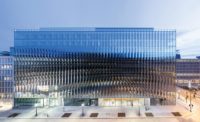Architect Joshua Ramus, founder of REX, sees Washington, D.C., as a blend of glass boxes among neoclassical, Beaux Arts, Art Deco, and Brutalist buildings—the latter of which, as the de facto style of government for its cheap production from the 1960s to the ‘80s, spreads across much of the District like what Ramus calls “a sea of taupe.” Given the District’s building height limitations, developers have often sought to maximize leasable square footage by building out to the extents of the zoning envelope, resulting in a seemingly endless stretch of glass curtainwall bisecting the city’s downtown.
In Washington, Ramus’s latest work is less about thinking outside the proverbial—and in this case, glass—box than it is about redefining the glass that composes it. The result is a modular, concave, unitized system that allows for nearly mullion-less glazing that wraps two sides of 2050 M Street, which is slated for completion in the coming months.
Likening the seams between glazing to the fluting of Corinthian columns, Ramus talks about the benefits, known to the ancient Greeks, of such a strategy: “We tend to use fluting whenever we're trying to emphasize verticality, not because of the vertical striations themselves, but the optical illusion that happens when you get a horizontal and a curve—the presence of the horizontal is downplayed,” he said at a recent hard-hat tour.
It’s a simple conceit—that of reducing horizontality in a city full of it—at which Ramus takes aim by revisiting glass studies his firm did almost a decade ago for the Vakko Fashion Center in Istanbul. He describes 2050 M Street as one idea, and two details: standard and corner connections between glass and slab. Working with facade consultant Front, with which REX shares an office in Brooklyn, the team developed a structural glazing system of 11-foot-6-inch concave units repeating over a five-foot bay, with glass mullion curvature of approximately 8 inches. “What we proposed would take all the benefits of curved, mullion-less storefront with all the efficiencies of a unitized system,” Ramus said at the D.C. edition of Record on the Road in May of this year.
For its work on the Vakko project, REX slumped a structural X-shape into the glass. Thanks to advances in slumping technology, a process that once would have taken 12 to 16 hours of controlled slumping and chemical strengthening has been reduced to two to three minutes. That’s part of how REX was able to redefine the procurement process for 2050 M Street, sending out the job to five far-flung glass companies and allowing them to enter competitive bids. Then Tishman Speyer bought all the glass from the fabricator with the best quality bid. With the connection details known, and the glass fabricated according to specifications ahead of time, installation has been as streamlined as the end result, which is a shimmering, mirage-like facade that alternatingly reflects and refracts light.
Early photography is otherworldly enough to produce questions of real versus rendering. And whether or not REX has broken out of the box paradigm, the firm has certainly made it a more beautiful one.









Post a comment to this article
Report Abusive Comment